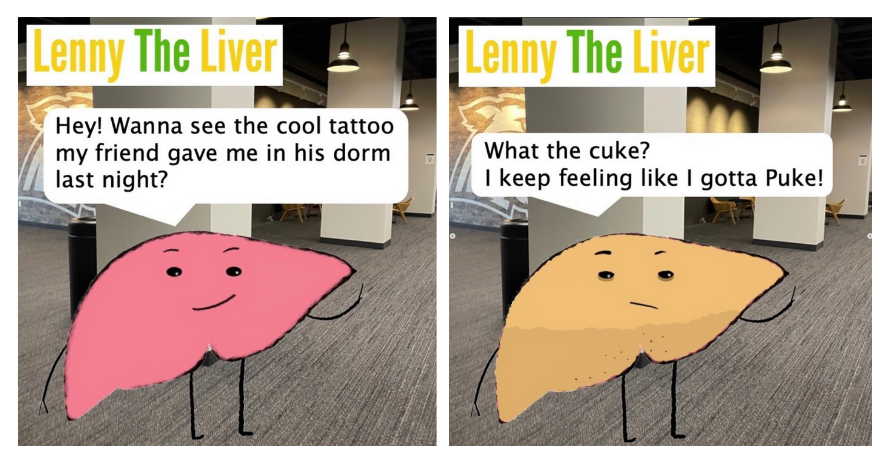NMU Students Use Social Media to Promote Hepatitis C Awareness
When Mark Shevy, NMU professor of Mass Communication and Multimedia Production, was searching for a service-learning project for his New Media Literacy class, he reached out to Elise Bur, director of the NMU Center for Rural Health. Shevy wanted a topic that could display a practical utilization of social media and would also benefit the Marquette community. Around the same time, Katreena Hite, a limited license master social worker (LLMSW) Integrated Care Specialist at NorthCare Network, also reached out to Bur about strengthening hepatitis C awareness in the region. Bur made the connection, and Professor Shevy’s SP 320 New Media Literacy class ended up planning a social media campaign promoting hepatitis C awareness and prevention.
Why Hepatitis C?
Katreena Hite has been working on an integrated care team at NorthCare Network, one of Michigan’s ten Prepaid Inpatient Health Plans (PIHPs), for almost six years. During her time, hepatitis C treatment had historically not been accessible in the state of Michigan due to a shortage of infectious disease physicians and high treatment cost. Hepatitis C is a liver infection caused by the hepatitis C virus (HCV). It is spread through contact with blood from an infected person. While people commonly associate hepatitis C with intravenous drug use, it can be spread in many unexpected ways. Most cases are medically acquired from being born to someone with hepatitis C, or are acquired through sexual transmission. (Source: CDC.org)

Prior to the pandemic, the State of Michigan had plans to focus on eliminating hepatitis C. According to Hite, the state has seen an increase in cases among young adults, where typically the disease occurs in those born between 1945 and 1965. The statewide push was put on hold due to the pandemic related public health crisis. Recently, the Michigan Department of Health and Human Services (MDHHS) began directing resources and promotion efforts towards advancing the hepatitis C initiative.
“Once the state started putting that pressure back on, I jumped at it,” Hite said. “Hepatitis C has been a condition that I care about because it can be cured in 99% of cases, and there’s a lot of stigma around the condition. We, as a society, have not put forth a lot of effort into treating individuals who have hepatitis C. There was an opportunity to increase awareness with other resources, but I didn’t have a massive systemic backing to push what I was hoping for. Now, I do!”
Getting tested for hepatitis C is essential because treatments can cure most people infected within 8 to 12 weeks. The CDC now recommends one-time testing of adults and during every pregnancy for women. For people with risk factors, regular testing is recommended. Recently, a new medication was released that is much more affordable than its predecessor. Treatment is available through outpatient services, and it is in pill form with low side effects and a 99% cure rate. Primary physicians are now able to order testing as well as monitor treatment. As new resources for the disease began appearing, Hite began brainstorming ways to get the word out to Michigan’s rural areas.
“An important thing for people to understand is when you look at a heat map of the infection rates across the state of Michigan; the rural communities have the highest per capita rates of hepatitis C infection,” Hite said. “When you look at that map, the U.P. is much darker, indicating high rates of prevalence, than almost all of the state. It’s more prevalent per person in a rural area than in an urban area.”
Enter SP 320…
SP 320 New Media Literacy is a course taught at Northern Michigan University where the overall goal is to examine relationships between communication technologies and society along political, economic, cultural, psychological, and physical dimensions. When Bur introduced professor Shevy to Hite’s need for hepatitis C awareness, it seemed like the perfect opportunity to incorporate service-learning and community health into the mission of his course.
“A combination of factors made it a good topic for our class at this time,” Shevy said. “These include new treatments that are low-cost and effective, a change in legislation that allows for more health clinics to treat it, and the spike of cases in college-aged students,” Shevy said.
To begin the project, Hite presented to Shevy’s class. She touched on the basics: What hepatitis C is, how people acquire it, how it can be treated, and the current trends that make it a timely topic for the university. Then, the class “ran with it.”
Through research and data collection, Shevy and the students of SP 320 found that the overall knowledge of hepatitis C among NMU students was low. The class created a cartoon character in the form of a liver named Lenny. The goal of Lenny the Liver was to educate people about hepatitis C in an organic way over a short period of time. Lenny has his own Instagram page, where he can be seen sharing stories and symptoms about hepatitis C and encouraging people to get tested.
The class was broken up into groups, and each group had to consider theories of new media literacy. While coming up with a strategy, one group created a character named Lenny the Liver. The intention behind this approach was to find something that will grab people’s attention and hopefully make them want to share. This led to the idea of creating a series of three-panel stories where Lenny would start off as a normal, healthy liver. On the second panel, he would be yellow, because jaundice is a symptom of hepatitis C. The third panel would encourage action.
Each group created a story about Lenny the Liver. In the first panel of each story, Lenny would describe something that he did, which happened to be an activity that causes hepatitis C. In the second panel, Lenny revealed that he was experiencing a symptom of hepatitis C. The last slide of every story would have the phrase, “Lenny should get tested for hepatitis C and so should you.”
 “The main objectives were to increase NMU students’ awareness of hepatitis C causes and symptoms, and to let them know they should get tested,” Shevy said. “This led to some surprising class discussions. After Katreena told us that unregulated tattooing is a source of hepatitis C, the students in class began talking about tattoo parties that they’d heard about . This resulted in a Lenny story in which Lenny got a tattoo from a friend in the dorm. It became the most-viewed story on Lenny’s Instagram account.” All information used in Lenny the Liver storylines are hypothetical.
“The main objectives were to increase NMU students’ awareness of hepatitis C causes and symptoms, and to let them know they should get tested,” Shevy said. “This led to some surprising class discussions. After Katreena told us that unregulated tattooing is a source of hepatitis C, the students in class began talking about tattoo parties that they’d heard about . This resulted in a Lenny story in which Lenny got a tattoo from a friend in the dorm. It became the most-viewed story on Lenny’s Instagram account.” All information used in Lenny the Liver storylines are hypothetical.
Other than some baseline information and education that she provided to the class, Hite said it was the students that really took control and ran with the project. She believes the project in Professor Shevy’s New Media Literacy class is an example of the potential that social media has to impact health care awareness in the Upper Peninsula.
“We all have platforms that can reach all of our social networks simultaneously. Instead of having individual conversations, we’re able to go out and mass produce,” she said. “There’s a lot of misconceptions about hepatitis C and it’s easier when you see information from somebody that you know. It is the increased reach that we have and how inexpensive it is. We don't have to spend advertising dollars on TV spots or newspaper ads; it's free to create something on social media and push it out."
A Win-Win Situation
In the end, this connection made by Bur turned out to be a beneficial situation to both parties. As Hite continues spreading hepatitis C awareness throughout the Region, Lenny the Liver has opened her mind to different ways of approaching populations who may not believe they are at risk for the disease.
“Testing and identification of cases are the most important pieces. The other crucial piece is eliminating the stigma around how people acquire hepatitis C. People tend to think it’s because of IV drug use, but most cases are not,” Hite said. “It doesn’t just impact people with a history of IV drug use; it impacts people from across the spectrum. That’s a crucial piece in eliminating that stigma and educating physicians that they need to be referring patients for testing.”
For Professor Shevy and his SP 320 class, it was a way to apply new media literacy theories to a real-life situation and think about how they could lead to innovation.
“We took it as an experiment to test new ideas developed from media theories. If we succeed in increasing hepatitis-C awareness far beyond our class, then we’ve learned something about media and done some good. If our strategy fails to reach a lot of people, then at least the students in our class know more about hepatitis C, and we’ve learned something to help make better strategies next time. It’s a win-win situation.”
You can follow Lenny the Liver’s journey of educating the public about hepatitis C on Instagram @lennytheliver21.
---
The Northern Michigan University Center for Rural Health seeks to improve the health and well-being of Upper Peninsula residents and communities by developing collaborative partnerships that enhance the access and availability of affordable, quality healthcare services. For questions or comments related to this story, contact ruralhealth@nmu.edu.
